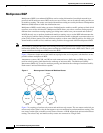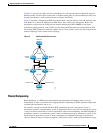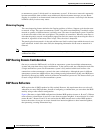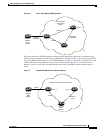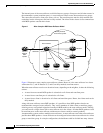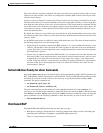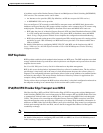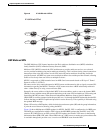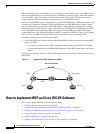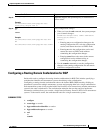
Implementing BGP on Cisco IOS XR Software
Information About Implementing BGP on Cisco IOS XR Software
RC-40
Cisco IOS XR Routing Configuration Guide
OL-14356-01
IPv6 Provider Edge Multipath
Internal and external BGP multipath for IPv6 allows the IPv6 router to load balance between several
paths (for example, same neighboring autonomous system [AS] or sub-AS, or the same metric) to reach
its destination. The 6PE multipath feature uses multiprotocol internal BGP (MP-iBGP) to distribute IPv6
routes over the MPLS IPv4 core network and to attach an MPLS label to each route.
When MP-iBGP multipath is enabled on the 6PE router, all labeled paths are installed in the forwarding
table with MPLS information (label stack) when MPLS information is available. This functionality
enables 6PE to perform load balancing.
VPNv4/VPNv6 over the IP Core Using L2TPv3 Tunnels
The Layer 2 Tunnel Protocol version 3 (L2TPv3) feature defines the L2TP protocol for tunneling Layer 2
traffic over an IP core network using Layer 2 VPNs. Benefits of this feature include:
• Simplifies deployment of VPNs
• Does not require Multiprotocol Label Switching (MPLS)
• Supports Layer 2 tunneling over IP for any traffic
• Supports data encapsulation directly over IP (IP protocol number 115), not using User Datagram
Protocol (UDP)
• Supports point-to-point sessions, not point-to-multipoint or multipoint-to-point sessions
• Supports sessions between the same Layer 2 protocols, for example Frame Relay to Frame Relay or
ATM to ATM
Note This feature is supported on Cisco XR 12000 Series Routers.
When an RFC 4364-based IP VPN service is deployed (see RFC 4364), VPN traffic is typically
transported across the core network between service provider edge (PE) routers using MPLS label
switched paths (LSPs). Native IP L3VPNs eliminate the need for MPLS between the participating core
routers by relying on scalable tunnel encapsulation over IP. These tunnels can be used instead of, or with,
MPLS to transport VPN traffic between participating edge routers.
A native IP L3VPN allows service providers to use an IP backbone to provide VPN services. BGP is
used to distribute VPN routing information across the provider backbone.
Figure 9 shows edge routers participating in switching IPv4 and IPv6 traffic over a tunnel using IP as
the transport.



